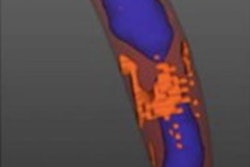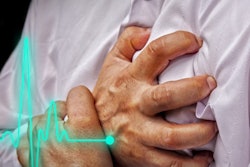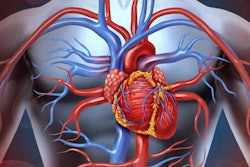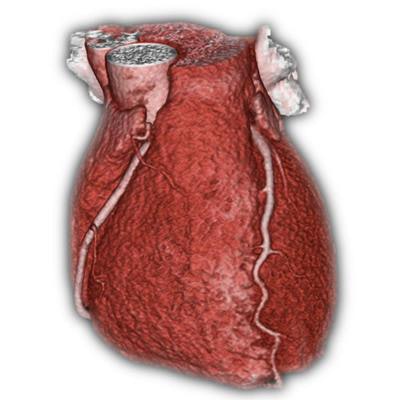
Coronary CT angiography (CCTA) is a safe gatekeeper for cardiac catheterization, reducing the need for intervention, boosting the diagnostic yield of interventions, and trimming minor procedural complications, reported German investigators writing in BMJ.
The study used CCTA to examine more than 300 patients, randomizing them to CT or invasive coronary angiography, and comparing outcomes in terms of procedural complications. They found the use of CCTA cut the need for invasive catheterization from 100% to 14%, and increased the diagnostic yield of invasive angiography (i.e., the number of positive exams), from 15% to 75%, while reducing the number of minor complications from intervention (BMJ, October 24, 2016).
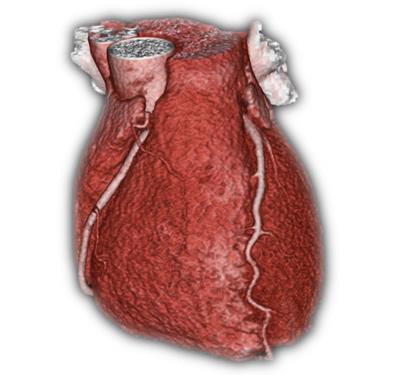 Three-dimensional CT scan shows normal coronary arteries. Images courtesy of Dr. Marc Dewey and the German Radiological Society (Deutsche Röntgengesellschaft, DRG).
Three-dimensional CT scan shows normal coronary arteries. Images courtesy of Dr. Marc Dewey and the German Radiological Society (Deutsche Röntgengesellschaft, DRG)."This randomized trial showed that in patients with atypical symptoms suggestive of coronary artery disease requiring coronary angiography, CT safely deferred invasive coronary angiography with no increase in long-term events, reduced minor but not major procedural complications compared with direct coronary angiography, and shortened the length of hospital stay," wrote lead author Dr. Marc Dewey from Charité University Hospital, Humboldt University, and Freie University in Berlin, and colleagues in several other centers.
The trouble with angiography
Coronary angiography has the advantage of allowing coronary stenting and planning of coronary artery bypass grafting during the procedure, the authors wrote. However, substantial evidence shows that invasive angiography has a low diagnostic yield that indicates potential overuse; it also has the potential for life-threatening complications.
 Dr. Marc Dewey.
Dr. Marc Dewey.CCTA's greatest clinical value may be its ability to reliably rule out coronary artery disease in patients with atypical presentation and low-to-intermediate pretest probability of disease, reducing the need for invasive catheterization and rendering it safer and more effective when it is needed.
The evidence on outcomes is mixed, however. In a multicenter trial in the U.S., CT did not improve clinical outcomes compared with functional testing, whereas the Scottish Computed Tomography of the Heart (SCOT-HEART) trial was found to reduce overall myocardial infarction on follow-up of patients with recent angina. So while CT may lead to fewer angina symptoms, testing, and costs while increasing radiation exposure, no study has analyzed the effectiveness of CCTA in a randomized comparison with coronary angiography.
Comparative effectiveness, complications
The study examined the comparative effectiveness of cardiac CT and coronary angiography in patients with suspected coronary artery disease and atypical angina or chest pain who were clinically referred for coronary angiography. The team also assessed the impact of CT on procedural complications, diagnostic yield of invasive angiography, length of stay, and other parameters.
The investigators included 340 patients (mean age 60.4, 50% women) with suspected coronary disease and a clinical indication for coronary angiography based on atypical angina or chest pain, randomizing them to CT (n = 178) or coronary angiography (n = 172). Independent investigators blinded to the outcomes assessed the results.
Drastically fewer invasive procedures
- CCTA reduced the need for invasive angiography from 100% to 14% (p < 0.001) and was associated with a significantly greater diagnostic yield for coronary angiography, from 75% to 15% (p < 0.001), the authors wrote.
- While major procedural complications were rare (0.3%) in both groups, minor procedural complications were less common in the CCTA group at 3.6%, compared with 10.5% in the angiography group (p = 0.014).
- The use of CCTA reduced the median hospital stay from 50.9 hours to 30 hours (p < 0.001), the group wrote.
- Adverse events were similar between groups. Median follow-up of 3.3 years revealed major adverse cardiovascular events in 167 CT patients (4.2%) versus 162 events (3.7%) in the angiography group.
- Minor complications during procedures were less common among the CCTA patients, at 3.6% versus 10.5% among angiography patients.
- Overall median radiation exposure was also similar between groups, at 5.0 mSv for CT and 6.4 mSv for invasive angiography.
- In all, 79% of patients said they would prefer CT over angiography for their next exam.
"CT was found to be a safe gatekeeper for invasive coronary angiography, with no increase in long-term events, and patients in the CT group had fewer minor, but not major procedural complications compared with those who underwent direct coronary angiography," Dewey and colleagues wrote.
CT was also associated with a five times greater diagnostic yield, defined as the percentage of invasive angiographies showing obstructive coronary disease. It also reduced the need for invasive angiography sevenfold, offering the potential of reducing the overuse of invasive procedures, the team wrote.
"The significantly shorter length of stay in the CT group might help reduce costs when CT is used in properly selected patients with atypical presentation," Dewey et al wrote.
The authors are currently scaling up the study with multiple centers to form what they call the DISCHARGE trial, with results due in 2020.
As for limitations, the prevalence of cardiac disease and revascularization rates were lower than expected, and the excellent results obtained at an academic heart hospital may not be replicated in different settings, the study team noted.
"CT safely deferred invasive coronary angiography with no increase in long-term events, reduced minor but not major procedural complications compared with direct coronary angiography, and shortened the length of hospital stay," wrote Dewey and colleagues. CT decreased the angiography rates and increased the diagnostic yield, but did not lower the radiation dose.
Finally, CT might be able to replace functional testing in some patients, inasmuch as it showed a reduction of unnecessary invasive coronary angiography in patients with atypical presentation, Dewey and colleagues reported.




